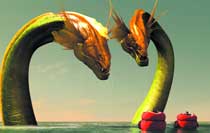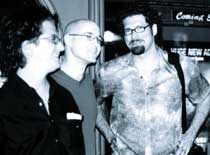
Janimation used Shake and DS HD to weave the sea monster, the kids, the splashes and the scene extensions into seamless shots.
|
DALLAS - It's like a kid's nightmare: You're stranded at sea when a giant sea serpent rises up from the depths. Its two heads swoop down menacingly to devour you and your companion.
It's like an animation professional's dream: Your 10-year-old computer animation company's first movie gig is with the director of what's become one of the hottest kids/action/fantasy movie franchises. He picks your team to conjure up the most outrageous hero shot in his new movie. And when it's released, Roger Ebert singles out your sea serpent as "kind of beautiful in its own way."
Dallas-based Janimation, run by founder Steve Gaconnier, had three months to design, model, animate, composite and render the two-headed sea monster that threatens the young spies in the new film Spy Kids 2: The Island of Lost Dreams.
Of all the animated creatures running and flying and scurrying around Spy Kids 2, the sea monster posed a big challenge for a small animation company. In two separate sequences the script's animatics called for two sets of kids, the stars and, later, their rivals (also siblings), to be marooned at sea off the coast of the mysterious island. In both scenes, the kids are seen bobbing in comically over-inflated diving suits after exiting their incapacitated submarines. As such, they are helpless when two monstrous heads rear up out of the sea and descend upon them, jaws open wide. In the first case, our heroes' inflated suits are ruptured by the monster's giant fangs and they skid across the sea to a bumpy landing on the lost island's beach. In the second, similar encounter, the kids who play the stars' fiendish rivals bob to the surface and scream in fear as the sea serpent resurfaces, this time determined to have a snack. The two grisly heads swoop down on the children, they suddenly lurch back, reacting comically to the kids' repellent stench - they'd previously fallen into deep camel dung. The serpent then bats the brats across the water and they wash up on the same beach.

At the Austin premiere of Spy Kids 2 (L-R) Greg Punchatz, Pete Herzog and Steve Gaconnier.
|
Such is the fantasy storyboard of today. However, despite Spy Kids 2's savvy homage to classic Ray Harryhausen work (there are vicious, dueling skeletons, for instance, created by Computer Cafe - see our films feature on page 24) you can't pull off shots like the sea monster's without masterful 3D animation and meticulous compositing skill - all rendered in film resolution HD.
Gaconnier and his team of eight animators made it happen on schedule, with the help of four to six freelancers who worked at Janimation (www.janimation.com) on an as-needed basis. And Softimage's XSI and DS HD played big roles.
SK2 was an all-digital 24p shoot, rather than film, and Janimation had equipment upgrades to meet the demands of feature film production. "We determined we would need to double our renderfarm with dual two-gig AMD processors, each with a minimum of a gig of RAM," says Gaconnier (pronounced "goss-on-YEA"). "Boxx Technologies provided our additional render power as well as new workstations. The workstations were extremely responsive, while the render monsters sat in the back and ran 24/7. Not only did the 3D team run XSI/Mental Ray on the renderfarm, but the 2D team was able to employ parallel processing when needed for larger composites."
With about 500 effects on its plate, Hybride Technologies (www.hybride.com) in Montreal was the lead visual effects house, with Daniel Leduc in charge. "Daniel Leduc and his team were readily available and extremely easy to work with," says Gaconnier. Both Hybride and Janimation run XSI as their main 3D system, "and this also made for smoother transitions for shots."
BUILDING THE BEAST
Janimation had additional help from Softimage technology that saved time and made it easier to weave freelancers into the workflow. One such treat, according to 3D supervisor Greg Punchatz, was the "Isner spine," a creation of Michael Isner of the Softimage special projects group. Applying the Isner spine to the big monster's two, sinuous necks allowed the animators to quickly animate each neck from only four control points as opposed to painstakingly animating the individual digital bones in a traditional set-up.
Another time saver, Punchatz says, was XSI's Synoptic view interface which Janimation's technical supervisor, Ludo Michaud, customized to allow staff animators and freelancers alike quick, easy access to select parts of their 3D characters without having to delve into the highly complex model underneath, or its UI.
Janimation provided numerous and various drawings of the sea monster before ultimately leaving it to the general design of Troublemaker Digital's Chris Olivia, the man who created SK2's many animatics. Director Robert Rodriguez, renowned for his personal involvement in so many aspects of the film (including its 24p cinematography), worked closely with Olivia on the animatics as well. During review and approvals of Janimation's work on the sea monster sequences, Gaconnier was in direct contact with Rodriguez via Hybride's realtime application called QuickTime Synchro. This allowed the Dallas-based animators to participate live in Rodriguez's review of their work at Troublemaker in Austin and provide immediate feedback without having to overnight dailies.
Gaconnier and Punchatz say that Rodriguez was pretty receptive to their ideas about the monster's look, despite his well-known imagination and artistic vision. One take that saw a lot of revision was the sea monster's comical reaction to the stench of the dung-covered kids. Retaining the sea monster's monstrosity was a concern. "Comedy timing is a very, very tricky thing," says Gaconnier. In the final rendered scene we see the beastly heads sniff their prey, then peer at each other in surprise and disgust. Their eyes do pop comically but, Punchatz says, they're "not too cartoony."
COMPOSITE THIS
Janimation also took on the compositing of the two-headed monster and the two pairs of spy kids into their watery setting. Led by Alex Neuman, this job included digitally extending the "sea" that surrounds the floating kids with Arete software. The kids were shot in Lake Travis, which is nearby Troublemaker's headquarters, and the shoreline had to be removed to depict a vast, deep sea. An unusual job for Janimation was to go out to their own local lake with a 70-foot crane and shoot practicals of splashes, sprays and wakes from water cannons and a wave runner. Gaconnier and the team also rigged a giant "jaw" and shot lake water dribbling down from it. The dribble later appears running off the monster's chin.
Gaconnier shot the practicals in 1080i rather than 24p at the suggestion of Hybride's Leduc. "We shot 60i in order to have the ability to create slow-motion plates," says Gaconnier. "Using the interlaced fields as frames made the shot half speed. It was useful to create a 'larger than life' effect on one of the big water splashes."
The compositing team mostly used Apple's Shake and DS HD to weave the sea monster, the kids, the splashes and the scene extensions into seamless shots.
PROJECTION
To check their progress, Janimation's Softimage DS HD system and an HD VTR served as the "proving ground" for the team's shots, which they would then project in a local movie theater. "Throughout the project, we would output our work in progress to a Sony HDW-F500," Gaconnier says. And Texan technical-know-how - this time in the form of Texas Instruments - was again the key. "With the help of TI and our local Cinemark theater, we were able to hook up the VTR directly to TI's DLP system and see our work projected on the big screen," he says. "This was one of the most important steps we took in finishing our shots. Allowing the whole team to see the detail level we needed to work within and have the opportunity to find all the anomalies that could not be seen on any of the monitors in the studio was a huge advantage."